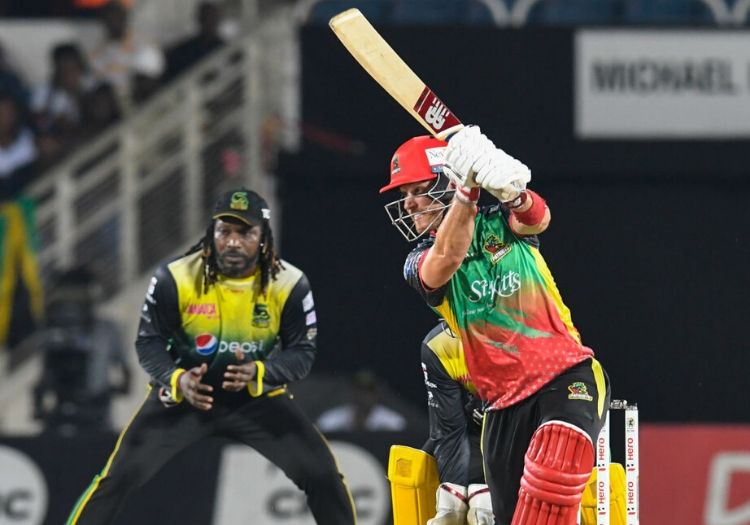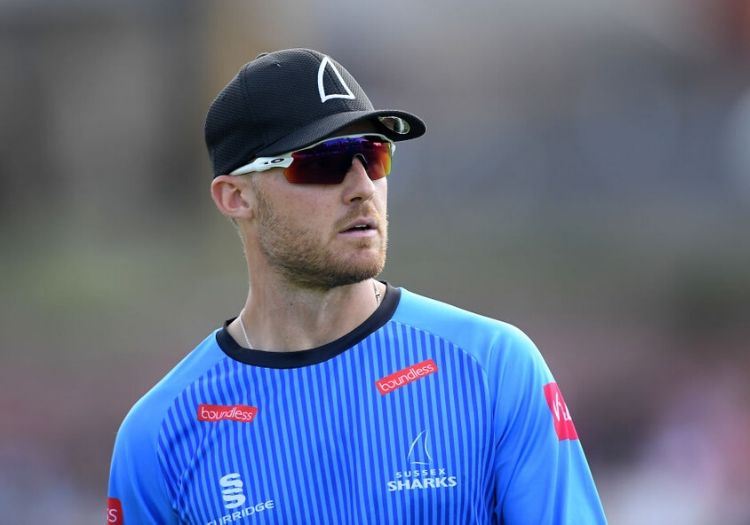NICK FRIEND: Evans has enjoyed a remarkable career surge - since the start of the 2018 T20 Blast, nobody has scored more runs in T20 cricket; he reflects on a breakthrough year, life as a coveted franchise commodity and a surprising Hundred draft

“I still think four-day cricket is the toughest form, certainly technically and mentally as a batter,” Laurie Evans stresses. “It doesn’t have as many highs and lows day-to-day as T20, but I think it’s the most rewarding if you score a hundred. A lot of hard work goes into it.”
He values each format as much as the next, he insists, even if his recent successes have seen him marked out as a white-ball cricketer.
It is certainly no sob story – and Evans does not intend to frame it as such. As a statement taken in its own right, it is merely a nod of appreciation amid an ever-changing personal landscape to what was once his bread and butter.
Even as the transformation of the Sussex batsman continues to take shape – there are few on the T20 franchise circuit with schedules as busy, there were still seven County Championship appearances over the course of the summer. Almost half of his red-ball runs came during a single effort – a century in a drawn encounter with Worcestershire.
The 32-year-old shares the same frustrations as his teammates and the Hove members – a feted bowling attack and a host of talented batsmen, but a promotion charge blighted by inconsistency.
Evans, though, is a most modern cricketer; few have benefited from the rise of the global T20 game – and even fewer have possessed the ability to do so – quite like him. As recently as 2016, he was loaned out to Northamptonshire to plug a hole in an injury-plagued Championship batting line-up. Three years on, he is among the most coveted properties on the franchise scene.
Since the beginning of 2018, just ten men worldwide have accrued more runs in T20 cricket than Evans. In the same timeframe, only four players – AB de Villiers and Glenn Maxwell among them – have made more runs in the middle period between the seventh and thirteenth overs.
In 2019, only Babar Azam, D’Arcy Short and Paul Stirling have struck more fours.
Between the end of September 2018 and the same date a year on, only Babar, Short and Colin Ingram faced more deliveries in the format.
It is that final statistic, perhaps, that is most significant. There is little sentiment in franchise cricket; it is a win-or-bust universe, with an intangibly lengthy queue of cricketers waiting to replace the non-performers.
Quite simply, you only reach the numbers hit by Evans if, indeed, you are worth having.
“People become flavour of the month,” he reflects of a brutally competitive industry. “For that period of time, that player might get picked up all over the world and then it depends on whether they do well or not.”

Laurie Evans represented St Kitts & Nevis Patriots in this season's Caribbean Premier League
Evans has ticked those boxes; since impressing Rashid Khan enough during the Afghan spinner’s stint at Sussex in 2018 to earn a deal with the leg-spinner at his Afghanistan Premier League side, the former Surrey batsman has been a man in demand.
Twelve months later, there have been spells with Multan Sultans in the Pakistan Premier League, with St Kitts & Nevis Patriots in the Caribbean equivalent and with Rajshahi Kings in Bangladesh, where he was comfortably his side’s top run-scorer.
“From a personal point of view, I’ve had a great couple of years,” he says. He would love to play in the Indian Premier League and the Big Bash to complete his set.
“You can’t really control whether you play in them,” he acknowledges with a chuckle. “You can have the best season – I’ve seen a couple of stats recently, so I know how well I’ve done in the last few years – but that doesn’t guarantee me into the Big Bash or IPL.
“I’m just trying to make the best of every opportunity possible. I don’t really think: ‘Right, I’d love to get picked up in that one.’
“You are pitting yourself against some of the best cricketers in the world, not just in your own country, so you can understand why you don’t get picked up in certain places – even when it doesn’t really make sense to you.”
To a degree, his success has been a development born out of a tactical switch; he moved up the order for Sussex at the start of the 2018 T20 Blast in search of a greater – and more meaningful – platform to showcase his talent.
Since the start of that competition, nobody has scored more runs in 'elite' T20 cricket than his 1,801; Colin Munro and Ingram are his closest challengers but even then, both have batted on 16 and nine more occasions respectively.
“It gave me that opportunity to then go and put weight of runs and match-winning performances in more often,” he explains of his venture further up into the crux of Sussex’ batting artillery.
“It just so happened that Rashid Khan was also with us for the Blast; he took me to the APL with him, but once you’re there you’ve got to perform.
“People aren’t going to keep picking you otherwise. Obviously, you’ve got to be fortunate enough to be given the opportunity, but at the same time you have to go and do well.
“I think I’ve had some pretty good tournaments throughout the world now, showing that I can play in different situations and on different surfaces, requiring different skills all the time.”

Sussex remains a key focus for Evans, even as his franchise career has taken off
His relationship with Rashid highlights the value of an influential voice; the Afghan has become one of the world’s best-known cricketers and his opinion holds sway in a format he dominates. As Evans says, however, that can only count for so much on its own. The onus is on the performer.
His record in successful chases since his shift to first drop sits at an average of 35.53, alongside a strike-rate of 156.48. In the same period, nobody has scored more runs in the final seven overs of winning second-innings chases – the business end. His strike-rate in that end-game is a freakish 210.32.
And yet, when the draft for The Hundred came around, he was the 92nd pick out of 96 – eventually snapped up by Oval Invincibles. On some occasions, that is to be anticipated – certainly it comes with the territory of entering a foreign competition as an overseas player. In that context, it is almost a lucky dip. But in a home tournament, where domestic players are key, one of T20’s standout batsmen could reasonably have fancied his chances.
Almost a month on, he is brutally honest about a stressful evening – there is no arrogance; he is well-aware that others missed out on both the chance to be involved and the accompanying payday. He is mightily grateful that his name did finally pop out.
“Look, I’d be lying if I said I wasn’t surprised that I went down so low,” he admits. “I was actually on the phone to Luke Wright for most of it; we both were fairly confident that we’d get picked up probably a bit higher than what we went for in the end.”
Wright, like Evans, was taken on an emotional journey. He holds the record for the most runs in the history of English domestic T20; no Englishman has made more hundreds in the format than his seven. Yet, the former England allrounder was the final name read out – 96 out of 96. ‘Mr Irrelevant’, as is the dubious honour in the NFL's equivalent.
“I’m not the one picking the teams,” Evans adds, knowingly. Drafts are like this – unpredictable, confusing, expectant of the unexpected, hard to explain.
“Coaches have all sorts of reasons for why they pick players. I’d be lying if I said I wasn’t surprised at how low I went,” he reiterates, “but at the same time it’s good to be involved. There’s a lot of good players who didn’t get picked.
“I didn’t watch it actually,” he laughs. “I was driving. My wife was trying to keep up to date with it on Twitter. I guess I was just quietly confident of being picked up and it would just depend on where.
“I had an idea roughly of what level I’d go in, but I started to watch before the end because I started to panic a little bit. It was an interesting night, that’s for sure.
“I really struggled, to be honest. Those last few moments and even after being picked, I don’t know what I was feeling – maybe a bit shocked, but also extremely happy to be picked as well. Relieved. Like I said, there’s a lot of people who didn’t get picked.”

Evans has played all over the world in the last 18 months
It would be hard to argue that any signing on a landmark evening for English cricket represented greater value for money than Evans. Even amid several unusual moments – “a lot of people were surprised by a lot of the picks,” he adds – it would be equally difficult to assert that any player’s price band was more out of kilter with what might have been expected.
There have been several theories around Evans’ last-gasp move, one of which centres around his scoring rate early on in his innings. Given the Hundred’s shortened format and the organisers’ insistence on talking in terms of balls rather than overs, there appears to be an additional pressure on batsmen to go hard and go early.
Over the course of the last two years, Evans’ strike-rate in his first ten deliveries when batting first has been 80.2. That has then seen a steep increase at each multiple; his figure from 11 to 20 is 137.1; between 21 and 30 it is 142.2; 31 to 40 then rises again to 155.6.
It is not a quirk that has proven troublesome elsewhere; Evans is part of the T10 League taking place in Abu Dhabi, where the only pressure – and the sole option – is to score heavily from the very first delivery. There is no time to waste.
“You realise how hard you can go without getting out,” he explains “In T20, some players hold themselves back because the game is 20 overs long.”
It was a point initially made by Jonny Bairstow after England and New Zealand each made 146 in their 11 overs in the series-deciding rain-reduced T20I at Eden Park. There, he highlighted the role of ten-over cricket in England’s self-belief; Bairstow himself made 84 from 24 balls in last year’s edition. They have learnt what is achievable.
“Sixes and wickets play a massive part in T20, whereas in T10 they lose their value in a way,” Evans suggests.
“If you bat at the top and you get going, there’s no fielding restrictions to stop you scoring. Certainly, if you don’t get the ball away and can’t find the boundaries there’s loads of pressure because all the fielders are up.
“In the middle overs, it’s easier to get off strike – there are no dot balls really, but then the fielders are out on the boundary.
“But it is all about clearing the ropes. Bowlers sort of feel sometimes they might as well just be running up and bowling underarm.”
Subscribe to The Cricketer this Christmas and receive a £20 John Lewis voucher or Alastair Cook’s autobiography. Claim your free gift here